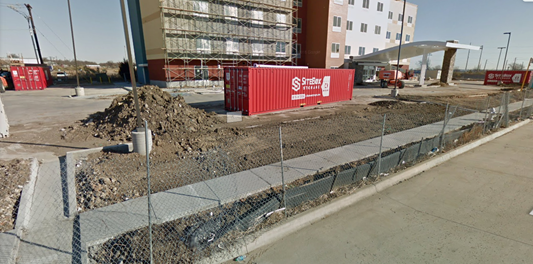How to Protect Your Tools and Heavy Equipment

Equipment theft keeps getting worse. If you're in construction, you know the sick feeling of showing up to a job site and realizing thousands of dollars in equipment vanished overnight.
The numbers are grim. Approximately 27.4% of construction sites report tool theft annually. Equipment theft causes an average loss of $12,850 per incident. And the worst part, over 68.2% of stolen tools are never recovered.
Criminals target job sites because the payoff is huge and risks feel low. Power tools, heavy equipment, vehicles, all have strong resale markets. But smart strategies combining physical security, technology, and good practices dramatically reduce your theft risks. Let's walk through what actually works.

Common Types of Equipment Theft
Understanding how thieves operate helps you block their strategies.
Opportunistic theft happens when criminals see easy targets. Unlocked containers, tools left out, minimal lighting, no cameras. They grab what's visible and valuable, then disappear.
Organized theft operations target specific equipment. Professionals with trucks, equipment knowledge, and buyers lined up. They scout locations, plan routes, disable security. Heavy equipment vanishes this way.
Internal theft by employees or contractors hurts too. Someone with legitimate access walking off with tools over time.
After-hours break-ins peak in late spring through early summer. Thieves hit sites when nobody's around. The longer equipment sits unmonitored, the higher your exposure.
Risk Factors for Tool and Equipment Theft
Some situations practically invite theft. Know your risk factors to prioritize security investments.
Remote locations top the list. Job sites far from main roads or regular traffic give thieves time. Law enforcement response runs longer too.

Inadequate lighting creates cover. Dark storage areas and minimal perimeter lighting make theft easier and detection harder.
Lack of barriers like fences signals easy access. If anyone can walk onto your site anytime, they will.
No surveillance means no deterrent and no evidence. Sites without cameras look like soft targets.
Poor inventory tracking means you won't know equipment is missing until days later. By then, it's gone.
High-value equipment left visible attracts attention. Expensive machinery visible from roads invites planning.
Businesses with multiple locations face amplified risks. More sites mean harder comprehensive security.
Securing Tools On-Site
Physical security forms your first defense. Making theft difficult discourages most criminals.
Portable storage containers solve multiple problems. Locking tools in secure storage reduces theft risk while protecting from weather. Steel construction resists break-ins better than sheds. Store tools inside overnight, every night.
Strategic placement helps too. Position containers where they're visible from main roads or areas with activity. Thieves prefer working unseen.
Quality locks aren't optional. Cheap padlocks get cut in seconds. Invest in hardened steel locks or lock boxes. Make thieves work harder, most will move to easier targets.

Remove keys and disable equipment. Heavy equipment with keys in ignition gifts it to thieves. Use battery disconnects, ignition locks, wheel locks. Hidden deactivation devices add another layer.
Secure the perimeter with fencing where practical. Eight-foot chain-link with barbed wire slows unauthorized access. Fencing won't stop determined thieves but increases their effort and exposure time.
Inventory Management and Tracking
You can't protect what you don't track. Proper inventory detects missing items early and aids recovery.
Detailed records of every tool should include make, model, serial numbers, purchase dates, photos. Keep this information off-site, if criminals steal your tools and records, recovery becomes impossible.
Regular inventory checks catch theft quickly. Daily counts of high-value items, weekly checks on everything else.
Mark everything valuable. Proper tool labeling decreases theft incidents by 21.9%. Engrave or stamp your company name or logo. Don't just paint markings, that's too easy to remove.
GPS tracking technology is getting cheaper. Using GPS tracking reduces equipment theft by 34.7%. Small units on heavy equipment let you track location in real-time. If something gets stolen, tell law enforcement exactly where it is.
Asset management software helps companies with extensive inventories. Track equipment at each location, who's responsible, maintenance schedules. This organization itself deters internal theft.
Use of Security Cameras and Alarms
Technology extends vigilance beyond human capacity.
Surveillance cameras serve dual purposes, deterrent and evidence. Visible cameras make criminals think twice. If they proceed, you've got footage. Modern systems offer night vision, motion detection, remote monitoring. Position cameras covering entry points, storage areas, high-value equipment.

Motion-activated lighting combined with cameras creates powerful deterrence. Criminals hate sudden bright light. Motion sensors triggering floods often send thieves running.
Alarm systems add warning layers. Break-in alarms on containers, motion sensors around perimeters, alerts to your phone. The faster you know about unauthorized access, the faster you respond.
Trail cameras work great on construction sites. Battery-powered, weather-resistant, affordable. Place them discretely monitoring equipment.
The key is making your site look harder to hit than the next one. Visible security measures push criminals elsewhere.
Locking and Storage Solutions
Not all storage provides equal protection. Understanding what works prevents false security.
Secure storage containers beat sheds or trailers. Steel construction, heavy-duty lockable doors. Containers designed for portable storage offer better security. Add interior shelving and tool racks for organization.

Job boxes and gang boxes work for smaller tools. Heavy-gauge steel, integrated locks. Bolt them down so thieves can't load the whole box.
Secure cabinets for especially expensive equipment add another layer. Power tools, electronics, surveying equipment deserve cabinet-level security inside containers.
Chain and lock combinations secure items that won't fit in containers. Chain heavy machinery to anchors. Use hardened chains and quality locks.
Layered approach works best. Perimeter fencing, then locked containers, then cabinets for highest-value items. Each layer slows thieves and increases exposure risk.
Employee Training and Awareness
Your team plays a crucial role in theft prevention, but they need guidance.
Security protocols should be clear and mandatory. Who secures tools at day's end? What's the checklist before leaving? Put one person in charge daily.
Recognition training helps employees spot suspicious activity. Unfamiliar vehicles. People photographing equipment. Questions that don't make sense. Teach your team to report concerns.
Accountability systems reduce internal theft. If employees are responsible for specific tools, theft from within becomes harder. Sign-out sheets and assignment records create paper trails.
Communication protocols for after-hours. If someone returns to the site outside normal hours, who do they notify? Criminals sometimes pose as contractors to access sites freely.
An engaged, security-conscious team catches problems early.
Insurance Options for Stolen Equipment
Insurance won't prevent theft, but covers financial losses when prevention fails.
Inland marine insurance typically covers tools and equipment at job sites. Verify your policy covers theft at remote locations and temporary sites.
Deductibles and coverage limits vary widely. Make sure coverage limits match your actual equipment value, being underinsured helps nobody.
Documentation requirements matter for claims. Insurance companies want proof you owned equipment, its value, and that theft occurred. Photos, receipts, serial numbers, police reports, gather everything.
Premium impacts from claims add up. Multiple claims drive premiums higher. Preventing theft saves more money long-term.
Review coverage annually. Equipment values change, inventory grows, policy terms shift.
Reporting Theft and Working with Law Enforcement
Fast, thorough reporting increases recovery odds.
Immediate reporting matters. The moment you discover theft, contact police. Hours matter. Equipment gets moved or sold fast.
Complete information helps recovery. Serial numbers, photos, GPS data, distinctive markings, last known location. More details mean better identification chances.
Follow-up persistence sometimes necessary. Stay in contact, provide additional information, ask about progress.
Industry reporting networks share theft information across companies. If criminals hit your site, they're probably targeting others. Sharing information helps everyone.
Remember that 68.2% of stolen tools never get recovered. Prevention remains your strongest strategy.
Technological Innovations in Theft Prevention
New technology keeps improving security options.
GPS tracking evolution continues making devices smaller, cheaper, longer-lasting. Modern trackers offer real-time location, geofencing alerts, historical movement data. Reduced equipment theft by 34.7%.
Smart locks and access control let you monitor who accesses storage when. Electronic locks, keypad entry, smartphone-controlled access create audit trails.
Telematics systems in heavy equipment track usage, location, diagnostics. Some systems remotely disable equipment if theft is suspected. Thieves who steal equipment that won't start often abandon it.
Drone surveillance provides coverage of large sites cameras can't reach. Periodic flyovers document conditions, verify security, spot unauthorized personnel.
Technology won't replace basic security but amplifies what human vigilance alone can't accomplish.
Frequently Asked Questions
How can I protect my tools from theft?
Lock tools in secure storage containers overnight. Mark equipment with permanent identification. Use quality locks. Install surveillance cameras covering storage areas. Maintain detailed inventory with photos and serial numbers. GPS tracking on high-value items helps recovery.
What are the best locks for securing equipment?
Hardened steel padlocks, disc locks, or lock boxes that cover the lock mechanism. Avoid cheap locks that cut easily. For containers, use heavy-duty outdoor locks. Electronic locks with access logs track who opens storage.
Are there alarms for tool theft prevention?
Yes. Motion-activated alarms on containers alert you to unauthorized access. Perimeter alarms detect fence breaches. Some send alerts to your phone. Combined with cameras, alarms provide real-time notification.
How do I mark my tools to deter thieves?
Engrave or stamp your company name, logo, or unique identifiers. Don't just paint markings, they're too easy to remove. Permanent marking makes stolen tools harder to sell, decreasing theft incidents by 21.9%.
What storage options secure tools effectively?
Steel portable storage containers provide best protection. Job boxes and gang boxes for smaller items, bolt them down. Secure cabinets inside containers for expensive items. Use chains and quality locks on equipment that won't fit containers.
Can GPS tracking help prevent equipment theft?
Absolutely. GPS tracking reduces equipment theft by 34.7%. Real-time location tracking helps law enforcement recover stolen equipment quickly. Geofencing alerts you if equipment leaves designated areas. Some systems remotely disable stolen equipment.
What insurance covers stolen tools and equipment?
Inland marine insurance typically covers tools and equipment at job sites. Verify your policy covers theft at remote locations. Keep detailed documentation, photos, receipts, serial numbers, for faster claims processing.
How should I document my tools for recovery?
Keep detailed records including make, model, serial numbers, purchase dates, and photos. Store this information off-site. Mark equipment permanently. Update records when buying new tools. Good documentation is crucial, 68.2% of stolen tools are never recovered.
Are there secure cabinets for expensive equipment?
Yes. Heavy-duty steel cabinets with integrated locks provide extra security inside containers. Use them for power tools, electronics, surveying equipment. Bolt cabinets to container floors. Layered security slows thieves.
What are common signs of potential equipment theft?
Unfamiliar vehicles repeatedly cruising your site. People photographing equipment without clear reason. Questions from strangers about security or equipment. Missing or tampered locks. Disturbed fencing. Train employees to report suspicious activity immediately.
Protecting tools and heavy equipment requires ongoing effort, but the alternative costs too much. Equipment theft causes an average loss of $12,850 per incident, plus downtime and replacement hassles. Start with basics, secure storage, quality locks, proper lighting. Add technology like cameras and GPS. Train your team. The layered approach works because each security measure increases criminal risk while decreasing your losses.
SiteBox Storage is ready to help protect your tools and heavy equipment by providing high quality, portable storage solutions. If you're ready to give mobile storage containers a try, contact us today.






